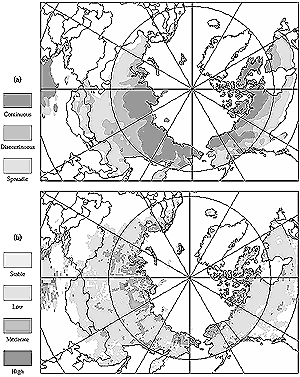16.2.5.2. Predicted Changes in Permafrost
|

Figure 16-7: (a) Zonation of permafrost
in the northern hemisphere under climate scenario predicted by ECHAM1-A
GCM (Cubasch et al., 1992). (b) Hazard potential associated with
degradation of permafrost under ECHAM1-A climate change scenario. Map
represents areas of stable permafrost and low, moderate, and high susceptibility
to subsidence. Classification is based on a "thaw-settlement index"
calculated as the product of existing ground-ice content (Brown et al.,
1997) and predicted increases in depth of thaw (Anisimov et al., 1997).
Hazard-zone intervals were derived through division of resulting frequency
distribution, using a nested-means procedure (Scripter, 1970).
|
Figure 16-1 illustrates the
geographic distribution of permafrost and ground ice in the northern hemisphere.
Computations based on a digital version of the map by Brown et al. (1997)
indicate that permafrost currently underlies 24.5% of the exposed land area
of the northern hemisphere (Zhang et al., 1999). Under climatic warming,
much of this terrain would be vulnerable to subsidence, particularly in areas
of relatively warm, discontinuous permafrost (Osterkamp et al., 2000).
Anisimov and Nelson (1997) conducted experiments with a simple model of permafrost
distribution driven by three transient GCMs (as reported by Greco et al.,
1994). Figure 16-7 shows the mid-range result from this
study; the area of the northern hemisphere occupied by permafrost eventually
could be reduced by 12-22% of its current extent. Experiments by Smith and Burgess
(1999) with a 2xCO2 GCM indicated that permafrost eventually could
disappear from half of the present-day Canadian permafrost region. Thawing of
ice-rich permafrost is subject, however, to considerable lag resulting from
the large latent heat of fusion of ice. Simulations by Riseborough and Smith
(1993), for example, indicate that areas of 5 m thick ice-rich permafrost near
the southern limit of the discontinuous zone in subarctic Canada could thaw
in less than 70 years. Where permafrost currently is thick, it could persist
in relict form for centuries or millennia. Figure 16-7
therefore is best regarded as indicating areas in which considerable potential
exists for changes in permafrost distribution. Nonetheless, pronounced changes
in permafrost temperature, surface morphology, and distribution are expected
(Smith and Burgess, 1998, 1999; Osterkamp and Romanovsky, 1999).
16.2.5.3. Environmental Impacts
The geological record of the Arctic shows abundant evidence for regional-scale
deterioration of permafrost in response to climatic change. Thawing of ice-rich
permafrost can result in subsidence of the ground surface and development of
uneven and frequently unstable topography known as thermokarst terrain. In unglaciated
parts of Siberia, alases (coalescing thaw depressions) formed during Holocene
warm intervals occupy areas as large as 25 km2. Cryostratigraphic
studies in northwestern Canada have documented thaw unconformities in the form
of truncated ice wedges associated with climatic warming during the early Holocene
(Burn, 1997, 1998). Warming of permafrost and thaw subsidence has been reported
widely from subarctic regions in recent years (Fedorov, 1996; Osterkamp and
Romanovsky, 1999; Osterkamp et al., 2000; Wolfe et al., 2000; Zuidhoff and Kolstrup,
2000).
Changes in active-layer thickness could have marked impacts on local environments
(Anisimov et al., 1997; Burgess et al., 2000a; Dyke, 2000). Thawing of perennially
frozen subsurface materials will create few problems where permafrost is "dry"
(Bockheim and Tarnocai, 1998). However, thawing of ice-rich permafrost can be
accompanied by mass movements and subsidence of the surface, possibly increasing
delivery of sediment to watercourses and causing damage to infrastructure in
developed regions. Many recent examples of such phenomena already have been
reported, and a poll conducted for the Canadian Climate Centre showed that most
of the engineers interviewed think that climate warming is a very important
factor for the stability of structures in permafrost regions (Williams, 1995;
Vyalov et al., 1998; Weller and Anderson, 1999). Weller and Lange (1999) note
that the bearing capacity of permafrost has decreased with warming, resulting
in failure of pilings for buildings and pipelines, as well as roadbeds. Accelerated
permafrost thawing has led to costly increases in road damage and maintenance.
In Alaska, for example, it costs as much as US$1.5 million to replace 1 km of
road system. However, eventual disappearance of permafrost reduces construction
problems.
Degradation of permafrost, which depends on the precipitation regime and drainage
conditions, poses a serious threat to Arctic biota through oversaturation or
desiccation of the surface (Callaghan and Jonasson, 1995). Changes in permafrost
and active-layer thickness will produce a complicated response. Development
of thermokarst in relatively warm, discontinuous permafrost in central Alaska
has transformed some upland forests into extensive wetlands (Osterkamp et
al., 2000). In contrast, climatic warming in the northern foothills of the
Brooks Range could lead to increasing plant density, resulting in evolutionary
transitions from nonacidic to acidic tundra or shrub tundra. Despite increasing
air temperature, such changes could prevent increases in active-layer thickness
(Walker et al., 1998).
|